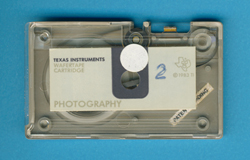
DATAMATH CALCULATOR MUSEUM
 |
DATAMATH CALCULATOR MUSEUM |
Texas Instruments WAFERTAPE CARTRIDGE
| Date of introduction: | never (Announced: 1983) |
Display technology: | |
| New price: | $5.95, $6.95, $7.95 (MSRP 1983) | Display size: | |
| Size: | 1.6" x 2.7" x 0.20" 40 x 68 x 5 mm3 |
||
| Weight: | 0.3 ounces, 8 grams | Serial No: | |
| Batteries: | n.a. | Date of manufacture: | |
| AC-Adapter: | Origin of manufacture: | ||
| Precision: | Integrated circuits: | ||
| Memories: | |||
| Program steps: | Courtesy of: | Joerg Woerner |

![]()
 Texas
Instruments introduced in January 1983 with the Compact Computer System
CC-40 the HEX-BUS, a very innovative port to connect peripherals in a daisy-chain mode very similar to the USB port released more than a decade later.
Texas
Instruments introduced in January 1983 with the Compact Computer System
CC-40 the HEX-BUS, a very innovative port to connect peripherals in a daisy-chain mode very similar to the USB port released more than a decade later.
 One of the peripherals planned for the Compact Computer family was the HX-2000 Wafertape, a continuous loop tape drive developed by Exatron and known as Stringy Floppy.
The Digital Tape Drive peripheral uses a small, endless loop, magnetic tape
called a Wafertape. The Wafertapes vary in length from 5 to 75 feet (1.5 to 22.5 m). The
tape speed is about 8 inches per second (0.2 m/s) and the motor runs only during
wafer access. Data density amounts to 1.5k Bytes per foot. However, the capacity
of a wafer is reduced significantly by a file directory, synchronization
patterns preceding data records and motor start/stop time considerations. Thus
the maximum access time and the amount of data storage can be traded off by
choosing the Wafertape.
One of the peripherals planned for the Compact Computer family was the HX-2000 Wafertape, a continuous loop tape drive developed by Exatron and known as Stringy Floppy.
The Digital Tape Drive peripheral uses a small, endless loop, magnetic tape
called a Wafertape. The Wafertapes vary in length from 5 to 75 feet (1.5 to 22.5 m). The
tape speed is about 8 inches per second (0.2 m/s) and the motor runs only during
wafer access. Data density amounts to 1.5k Bytes per foot. However, the capacity
of a wafer is reduced significantly by a file directory, synchronization
patterns preceding data records and motor start/stop time considerations. Thus
the maximum access time and the amount of data storage can be traded off by
choosing the Wafertape.
Texas Instruments was planning to offer three different Wafertapes with a maximum capacity of up to 48k Bytes:
|
• 50-foot - MSRP (1983): $7.95 • 25-foot - MSRP (1983): $6.95 • 10-foot - MSRP (1983): $5.95 |
The HX-2000 Wafertape had major reliability issue and was never released to the market. Without any other means for mass storage of programs and data, Texas Instruments developed consequently the Compact Computer 40 Plus with an integrated port to connect a cassette audio recorder to save programs or data files on tape.
Texas Instruments dropped out of the home computer market in March 1984 - after selling more than 2.5 million of the famous TI-99/4A - and production of the CC-40 was ceased immediately after. The CC-40 Plus never made it to the market and only a few prototypes survived.
If you have additions to the above article please email: joerg@datamath.org.
© Joerg Woerner, October 27, 2019. No reprints without written permission.